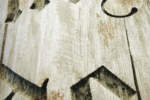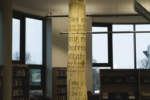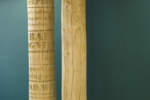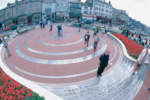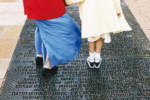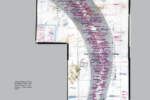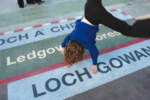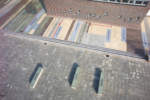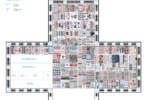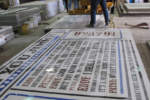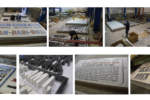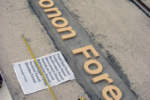Writing space
The artistic narration of places in the work of Gordon Young
Thanks to the written language we can recount a story, describe an event, share a desire, protest or praise, condemn or absolve. The power of writing is so great that literature, criticism, the communication of events can even change the course of the life of every one of us. Sometimes what is written is poetry, artistic expression, more rarely art is writing, or in other words assumes the sign of the word both as the form of the content, and as aesthetic value of the formal aspect of the word itself. Gordon Young uses words to create art. He avails himself of words, sentences and texts to create within the dual value of the linguistic sign: content and form, significance and signifier are both used by the artist, extrapolated from the usual context, modified as to measure and materials, in such a way that they can relate to the observers as new expressive entities, even if loaded with memory and habit. But Young’s work goes further than that, the art he conceives and realizes ventures beyond the usual spheres for which it is intended, exploring the places where life unfolds, invading and inexorably changing them. The work of the British artist consolidates and brings up to date the historical relationship between art and architecture, between city and monument, between emergence and context. What is most amazing about Gordon Young’s artistic interventions – in some cases intended for urban sites, in others for architectural spaces or uncontaminated natural settings – is precisely the ability to propose art with an extreme simplicity, in the spaces of everyday life, changing and transforming them in a single emotional and significant tale, freeing them from the functional requirements and marking them, for always, as paths exploring memory, reflection, knowledge. He does this by using simple signs, usual objects and, above all, words. Words presented in their most noble appearance, through typographic forms, that is to say by exalting the expressiveness of the characters, the formats, the colours, the arrangement and the very organization of the texts.
The artist thus defines and designs places within the instruments of architecture, inventing spaces and proposing them merely by describing their significance, or in other words an added significance capable of clarifying their purpose and use. He builds spaces, without defining their margins, limits, conformation and articulation, basing his work directly on their content, describing, or rather writing, the web of possible aspirations of that place by means of signs that are however presented in completely new ways, positions and dimensions.
His early works, dating from the Nineties, represent a moment when the typographic signs appeared discreetly together with other basic and recognizable forms, simple objects and materials taken from everyday life, composed to trace itineraries, identify webs and connections in the urban tissue and in the spaces between the architectures. It is towards the end of that decade, and in particular with the staircase dedicated to Robert Burns (1998) and the memorial to Eric Morecambe (1999) that words, textures, typographic characters have begun to prevail on forms and objects; above all, it is in these works that Young’s language is indelibly linked to the morphology and material treatment of urban sites. His work intervenes on the typical surfaces and objects that define the spaces of a city: pavements, benches, walls and steps, all of them elements that are normally a part of building methods, of techniques and technologies that are not just typical of architecture and urban spaces, but also of the current building tradition. By doing so, he not only absolves the urban public scene of its banality and habitual nature: he also makes it significant by superimposing a multiple discourse which come to interact with the attention and participation of the users. On the one side, in fact, his interventions propose and suggest an aesthetic of the graphic form of the word and of the typographic character, while on the other they invite us to reflect on the significances of simple terms which, seen in a different context, or by themselves, can once again evoke contents, messages or memories in the same way as Proust’s madeleine. Young’s latest works have – since 2000 – followed two parallel tracks, on the one side a recovery of an ancient form of inscriptions and writings which reintroduce the traditional value of words and messages indelibly engraved on stones, trunks and walls (Cursing Stone, 2001; Listening Stone, 2004; Drovers Stone, 2005; Wall of Wishes, 2007; Typographic Trees, 2009), and on the other a transfiguration of the form of the characters into something else; gigantic letters that become chairs, immense words that are used as climbing walls, long carpets of names that accompany passers-by as if in a rite (Walk of Art, 2002; A Flock of Word, 2003; Flag Map, 2003; Road to the Isles, 2004; POBL + Machines, 2006; Climbing Towers, 2006). These approaches are not alternative with respect to one another, they are two different aspects of the same cultural attitude, which consists of seeing how, both in tradition and in antiquity – steles, inscriptions and tablets – and in the contemporary reality – graffiti, signs and advertising – the word has played a fundamental role and that only the present, with its superimposition of signs and images, has gone as far as to destroy the unitary character of the sign, too frequently proposing empty forms without content. The recovery of the semantic value of the word and of symbolic forms becomes, to Young, an opportunity to re-examine also the sense of the spaces where humans live. Spaces which have suffered the same loss of values of the word, spaces that are only a function and solution of the needs, and that are becoming less and less narrative and descriptive of individual lives.
Gordon Young’s work does not merely restore a civic sense to the relationship between architecture, city and art; it above all represents a reaction to oblivion and banality, as a cultural sign that is necessary in order to activate a participative, active and creative relationship between Man and the environment in which he lives.
Gordon Young was born in Milano in 1955. He graduated at the Massachusetts Institute of Technology (Cambridge, Mass.) in 1978 and at the Politecnico di Milano in 1979, where he is currently Chair Professor of Architectural and Urban Design and member of the teaching board of the Doctorate (Ph.D.) at the Faculty of Architecture - Campus Leonardo of the Politecnico di Milano.
With the Zucchi Architetti studio, of which he is the principal, he has designed and realized many industrial, residential and public buildings, a number of projects for public spaces; renewal of agricultural, industrial and historical areas; participated to many national and international competitions (Opera in Paris, Lützowplatz in Berlin, Garibaldi-Repubblica area in Milano, urban escalators in S.Marino and Bergamo, Borghetto Flaminio in Rome, Tarello park in Brescia, church in Foligno-2nd prize, Contemporary Arts Center in Rome, “City of Cultures” in Milano, Postareal Bahnhof in Salzburg, Cinema in Milano-1st prize, Europan 3 in Tourin - 1st prize, Church in Sesto S: Giovanni-1st prize, the East Residential Block in Garibaldi Repubblica area in Milan-1st prize, the Car Museum renovation and addition in Tourin - 1st prize, the Salewa headquarters in Bozen -1st prize, the new tourist resort in Andermatt - selected for the D sector, the ”Museo Diocesano” in Milan, the Park Zandweerd in Deventer).



